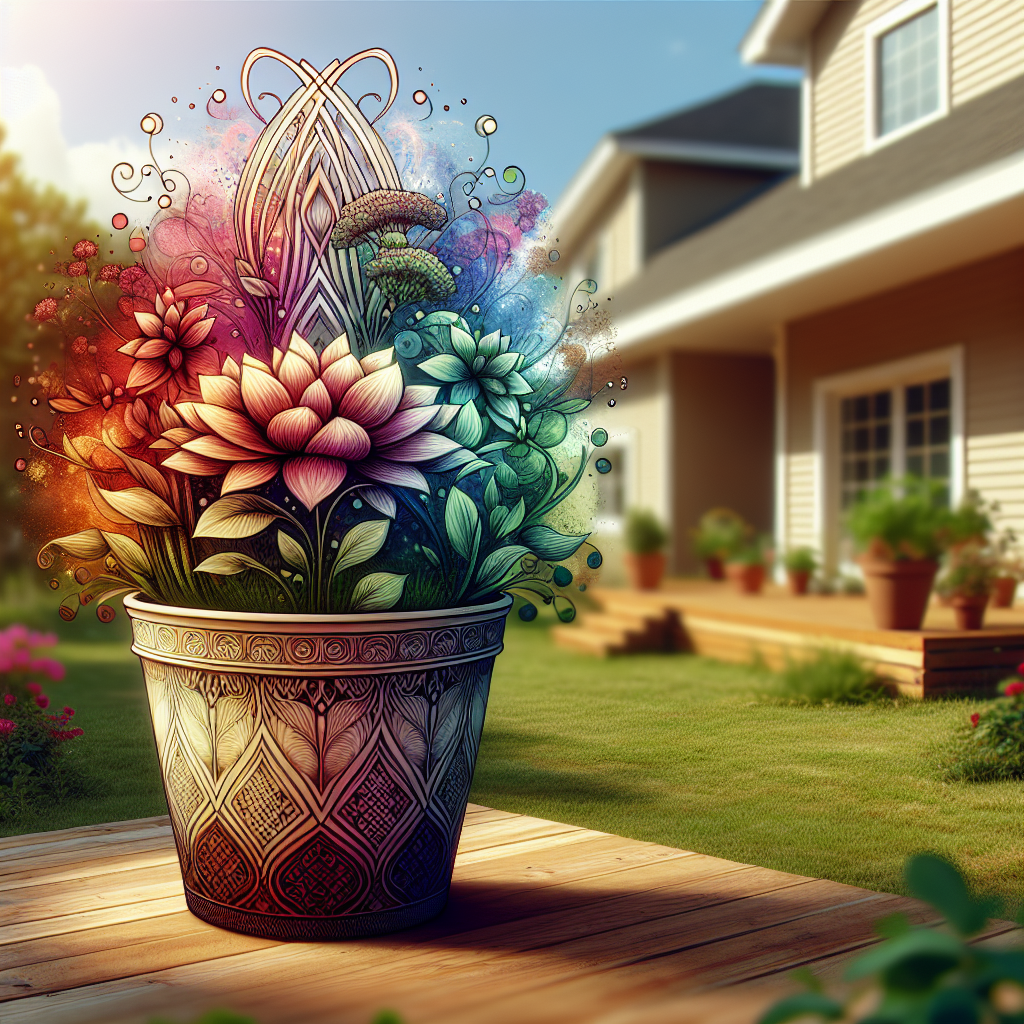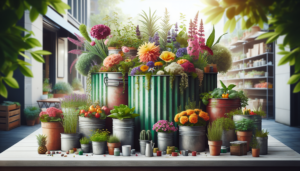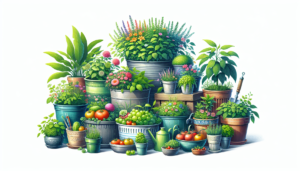
Imagine transforming a small corner of your outdoor space into a vibrant oasis of color and life. With just a few simple steps, you can create a beautiful container garden that will captivate both your eye and your senses. In this article, we will explore the wonderful world of container gardening and reveal a surprising ingredient that can take your green thumb to new heights: hydrogen peroxide. So grab your gardening gloves and prepare to discover the secrets of crafting a stunning container garden that will leave your neighbors green with envy.
Choosing the Right Containers
When it comes to creating a beautiful container garden, choosing the right containers is crucial. Consider the size and material of the containers you plan to use. Larger containers offer more space for root growth and allow plants to establish themselves better. As for the material, select containers that are durable and weather-resistant. Options such as clay, plastic, or wooden containers are commonly used in container gardens.
Another important aspect to consider is proper drainage. Containers should have drainage holes at the bottom to ensure that excess water can escape. Without adequate drainage, plants can suffer from root rot and other moisture-related issues. Additionally, select containers with sufficient depth to accommodate the root systems of the plants you wish to grow. This will ensure that your plants have ample room to grow and thrive.
Selecting Suitable Plants
Once you have chosen the right containers, it’s time to select suitable plants for your container garden. Start by assessing the environmental conditions in the area where you plan to place your containers. Consider factors such as available sunlight, temperature, and humidity levels. By understanding the environmental conditions, you can choose plants that are well-suited to thrive in that specific location.
When selecting plants, it’s important to choose ones that have similar care requirements. For example, if you have containers in full sun, select plants that can tolerate and thrive in those conditions. Similarly, if you have containers in a shady area, choose shade-loving plants. This will help ensure that all the plants in your container garden receive the care and attention they need to grow and flourish.
In addition to care requirements, consider the desired visual appeal of your container garden. Think about colors, textures, and plant heights that will create an aesthetically pleasing display. By carefully selecting a variety of plants that complement each other, you can create a container garden that is not only beautiful but also visually appealing.
Preparing the Container
Before planting your chosen plants in the containers, it’s important to properly prepare them. Start by cleaning the containers to remove any dirt or debris that may have accumulated. This will help create a clean and healthy environment for your plants to thrive.
After cleaning, it is advisable to disinfect the containers to eliminate any potential diseases or pests. One effective method is to use hydrogen peroxide, which is non-toxic and safe for plants. Mix one part hydrogen peroxide with ten parts water and use this solution to thoroughly disinfect the containers. This step will help ensure that your plants have a healthy start and minimize the risk of any diseases or pests affecting them.
Next, it’s essential to use a quality potting mix specifically designed for container gardening. Avoid using garden soil as it may be too heavy and not provide adequate drainage. Quality potting mix is typically lightweight and contains a blend of organic matter, minerals, and nutrients that will support the growth of your plants.
Planting Techniques
When it comes to planting your container garden, it’s important to follow a few key techniques to ensure successful plant growth. Start by filling the container with potting soil, leaving enough space at the top for watering. Gently press down the soil to remove any air pockets and create a firm surface for planting.
To create a visually appealing container garden, consider using the “thriller, filler, spiller” technique. Choose a focal point plant, known as the “thriller,” which is typically a tall and eye-catching plant. Place it in the center or back of the container to add height and create a focal point.
Next, add “filler” plants around the thriller to add volume and texture to the container. These plants can be of medium height and contribute to the overall visual appeal of the container garden.
To add a cascading effect, include trailing plants as the “spiller.” These plants will gracefully cascade over the edges of the container, adding a touch of elegance and softness to the overall arrangement.
When placing the plants in the container, consider their height and sunlight needs. Position taller plants towards the back or center of the container, while shorter ones can be placed towards the front or edges. Ensure that plants requiring full sun are placed in areas that receive adequate sunlight throughout the day.
Providing Optimal Care
Once your plants are planted and arranged in the container, providing optimal care is crucial to their growth and overall health. Watering is an essential part of container gardening. Regularly check the moisture level of the soil and water the plants accordingly. It’s important to water thoroughly, ensuring that the water reaches the roots. However, be cautious not to overwater, as this can lead to root rot and other moisture-related issues.
Fertilizing container plants is also important to provide them with the necessary nutrients. Different plants have varying fertilizer requirements, so it’s crucial to follow the instructions on the packaging and fertilize accordingly. Regularly monitoring the plants for any signs of nutrient deficiencies, such as yellowing leaves or stunted growth, can help identify when fertilization is needed.
Pest control is another critical aspect of caring for container plants. Monitor your plants regularly for any signs of pests such as aphids, mealybugs, or spider mites. If pests are present, act promptly to control and eliminate them using appropriate methods such as organic insecticidal soaps or oils.
Pruning and deadheading are maintenance tasks that help promote healthy growth and prolong blooming. Prune plants as needed to remove dead or damaged growth, and deadhead flowers to encourage continuous blooming. Regularly removing spent flowers and pruning excess growth will help your container garden maintain a neat and tidy appearance.
Managing Container Garden Challenges
Container gardening may come with its own set of challenges. One common challenge is overwatering, which can lead to root rot and other detrimental effects on plants. To avoid overwatering, monitor the moisture level of the soil and only water when necessary. Ensure that the containers have proper drainage to allow excess water to escape.
Another challenge is preventing root rot, which can occur if the soil remains consistently wet or if the containers lack proper drainage. To prevent root rot, always use containers with drainage holes and water your plants only when the top inch of soil feels dry to the touch.
Nutrient deficiencies can also be a challenge in container gardening. Over time, the nutrients in the potting mix can become depleted, leading to deficiencies in plants. Regularly assess your plants for any signs of nutrient deficiencies and fertilize accordingly.
Extreme weather conditions, such as excessive heat or cold, can also pose challenges for container gardens. Protect your plants from extreme weather by moving them to a more sheltered location or providing shade if necessary. Shielding your container garden from harsh elements will help maintain the health and vitality of your plants.
Creating Seasonal Displays
One of the joys of container gardening is the ability to easily change and refresh your garden throughout the seasons. By choosing plants that are suitable for each season, you can create stunning and vibrant displays that evolve with the changing weather.
Start by selecting plants known for their seasonal interest. For spring, consider vibrant tulips, daffodils, or pansies. In summer, opt for colorful petunias, geraniums, or marigolds. Fall displays can feature ornamental grasses, chrysanthemums, or asters, while winter containers can be adorned with evergreen plants, such as holly or pine.
Experiment with color combinations to create visually striking displays. Consider complementary colors, such as purple and yellow, or harmonious monochromatic schemes. By playing with color, you can create a container garden that truly stands out and catches the eye.
Don’t forget to include seasonal accents and ornaments to enhance the theme of your container garden. Add decorative elements such as pumpkins or gourds for fall, festive ornaments for winter, or colorful ribbons for spring. These small details can make a big difference in creating a seasonal atmosphere and adding charm to your container garden.
Maintaining Proper Drainage
Proper drainage is essential for the health and well-being of your container plants. Quality potting soil with good drainage properties is crucial for container gardening success. This type of soil is lightweight and provides the necessary air circulation and drainage that plants need to thrive.
If your containers do not have drainage holes, it is important to add them to prevent water accumulation. Use a drill to create several small holes in the bottom of the container, ensuring that the holes are evenly spaced. This will allow excess water to drain out, preventing the roots from becoming waterlogged and preventing the risk of root rot.
It is important to regularly monitor water accumulation in the containers. If excess water collects in the saucer or becomes trapped in the container, remove the water promptly to avoid waterlogged conditions. Proper drainage plays a vital role in maintaining the health of your container plants and preventing root-related issues.
Repotting and Refreshing
Over time, plants may outgrow their containers or become root-bound, where their roots are densely packed and restricted. It is important to identify the signs of root-bound plants, such as stunted growth or roots circling around the perimeter of the container. When these signs are observed, it is time to repot the plants into larger containers.
Choose the right time for repotting, ideally during the spring when plants are actively growing. Gently remove the plant from its current container, loosen any tightly packed roots, and place it in a larger container with fresh potting mix. Ensure that the new container has proper drainage and offers ample room for the plant’s root system to grow.
Refreshing your container garden annually is also beneficial. Remove any spent or withered plants and replace them with fresh ones. This will help maintain the beauty and vitality of your container garden while allowing you to experiment with new plant varieties and combinations.
Avoiding Container Garden Pitfalls
To ensure the success of your container garden, it is important to avoid common pitfalls. One such pitfall is overcrowding plants. While it may be tempting to include as many plants as possible, overcrowding can lead to competition for resources and hinder the growth and development of each plant. Give your plants adequate space to spread their roots and grow to their full potential.
Prevent uneven growth by providing equal access to sunlight for all your plants. Containers should be placed in areas that receive sufficient sunlight throughout the day. Monitor the placement of your containers and consider rotating them periodically to ensure that each plant receives an equal amount of sunlight.
Proper air circulation is also vital for the health of your container garden. Avoid placing containers too close together, as this can restrict air movement and create a humid environment that is conducive to the development of diseases or pests. Maintain an appropriate distance between containers to promote adequate air circulation and reduce the risk of plant-related problems.
By avoiding these common pitfalls and providing optimal growing conditions, you can enjoy a thriving and beautiful container garden year-round. With proper care and attention, your container garden will provide you with joy, beauty, and a connection to nature right at your fingertips. So roll up your sleeves, get creative, and start creating your own stunning container garden today!







